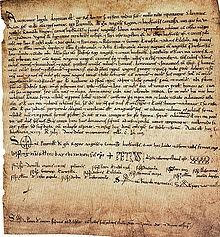Petronilla I of Aragon
Petronila I of Aragon (June 29, 1136, Huesca - October 15, 1173, Barcelona) was Queen of Aragon between 1157 and 1164 and Countess of Barcelona between 1162 and 1164. She was the daughter of Ramiro II the Monk and Agnes of Poitou.
Biography
It was conceived to give continuity to the Aragon dynasty. After King Alfonso I the Battler died without issue, he bequeathed all his territories to the military orders. The nobles did not accept him, so they took his brother out of the monastery where he was to proclaim him king. Ramiro II, nicknamed "the Monk" since at that time he was living in a convent, married Agnes of Poitou, and Princess Petronila was born from that marriage on June 29, 1136.
One year later, the marriage agreements were signed in Barbastro (regulating the royal potestas) with the Count of Barcelona, Ramón Berenguer IV, thus unifying the kingdom of Aragon and the county of Barcelona. Thus, the problems of succession in the Kingdom of Aragon were settled. Ramiro II retired to the monastery of San Pedro el Viejo in Huesca, keeping for himself the title of king, and Inés de Poitou returned to France.
Petronila was educated at the Barcelona court. The Archive of the Crown of Aragon, ACA, located in Barcelona, preserves the original document from the year 1137 in which Ramiro II of Aragon communicated to his subjects the donation of his daughter Petronila and his entire kingdom, to the Count of Barcelona Ramon Berenguer IV. Dated in Zaragoza on November 13, 1137, the abdication of the Resignation of Zaragoza (1137) is considered the beginning of the Crown of Aragon.
Despite the wishes of King Ramiro II, for thirteen years there was pressure from the Crown of León to try to marry her with Alfonso VII of León or with his son Sancho el Deseado, in order to unite the crowns of León and Aragón, imposing the name of Urraca on Petronila. In the end, this link was not carried out...
Doña Petronila's wedding to Ramón Berenguer IV took place thirteen years later in Lérida, in the month of August 1150, when the queen reached the age required by Canon Law to be able to consummate the marriage, fourteen years.
In March 1157, the couple's eldest son was born in Huesca, interchangeably called Alfonso and Ramón, who will reign under the name of Alfonso II in honor of Alfonso I. After the death of Ramón Berenguer IV in 1162, Petronila abdicated in Alfonso II the Kingdom of Aragon and the County of Barcelona in a document dated June 18, 1164 ("Actum est hoc in Barchinona XIIII kalendas julii anno Dominice incarnationis M C LXIIII.") After giving up her crown and a second marriage, she lived privately and holyly for the rest of her years. She died in Barcelona on October 15, 1173. She was buried in the Barcelona Cathedral.
Descendants
From her marriage to Ramón Berenguer IV she had:
- Infante Pedro de Aragón (1152-before 1158), referred to as nasciturus (son to be born) in a testament given by Petronila de Aragón on April 4, 1152, being in the labors of labor together with Barcelona (“in partu laborans, apud Barchinonam»). He died before 1158, perhaps shortly after the birth.
- The Infante Alfonso II of Aragon (1157-1196), King of Aragon and Count of Barcelona.
- The infant Pedro de Aragón (1158-1181), who in 1173 will be appointed Count of Provence by his brother Alfonso II, as Ramón Berenguer IV of Provence.
- The Sweet Infant of Aragon (1160-1198), married in 1175 with King Sancho I of Portugal.
- The infant Sancho de Aragón (1161-1223), count of Cerdaña, Provenza and Rosellón.
Used bibliography
- Ernest Belenguer, Felipe V. Garín Llombart and Carmen Morte García, The Crown of Aragon. The power and image of the Middle Ages to the Modern Ages (siglos XII - XVIII) (breakable link available on the Internet Archive; see history, first version and last)., Sociedad Estatal para la Acción Cultural Exterior (SEACEX), Generalidad Valenciana y Ministerio de Cultura de España - Lunwerg, 2006. ISBN 84-9785-261-3
- Benito Vicente de Cuéllar, "The Counts-Reyes" of Barcelona and the "acquisition" of the kingdom of Aragon by the dynasty bellónida", Hidalguía, vol. XLIII, n. 252, 1995, pp. 619-632
- De Salazar and Acha, Jaime (2006). «Urraca. An egregio name in the onomestic highmedieval». In Spain Medieval. Rabbit I: 29-47.
- Ana Isabel Lapeña Paúl, Ramiro II of Aragon: the monk king (1134-1137)Gijón, Trea, 2008. ISBN 978-84-9704-392-2
- Voice "Petronila" in the Great Aragonese Encyclopedia (online). Archived on 6 March 2016 at Wayback Machine.
- Miguel Rosell, 1945, no 17. Text digitized by Universidad Jaime I, doc. 3o, 1164, juny 18. Barcelona.
- Antonio Ubieto Arteta, Creation and development of the Crown of Aragon, Zaragoza, Anubar (History of Aragon), 1987.
Contenido relacionado
Etruscans
Cantabrian lábaro
Garcia I of Leon

